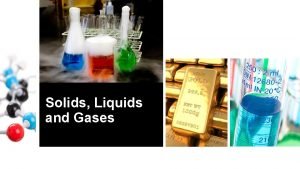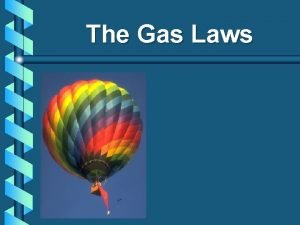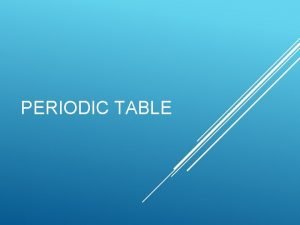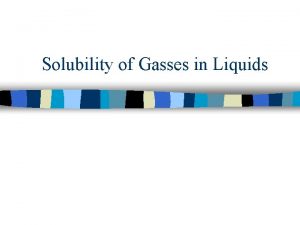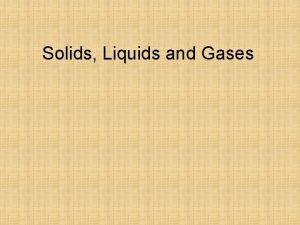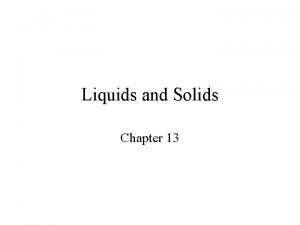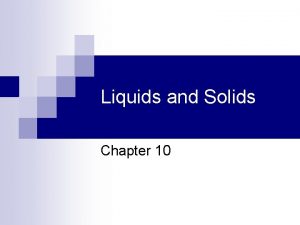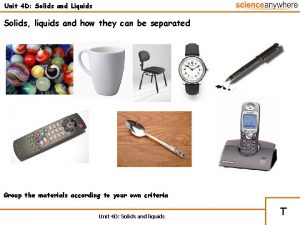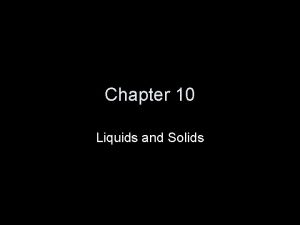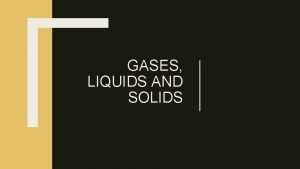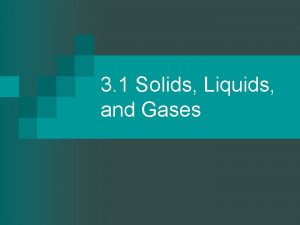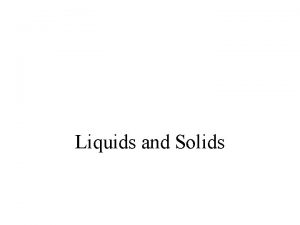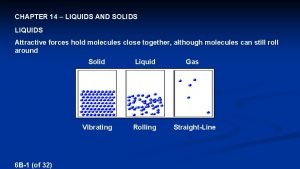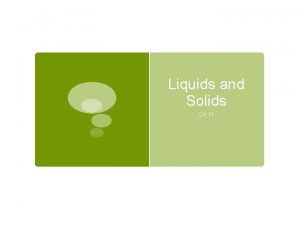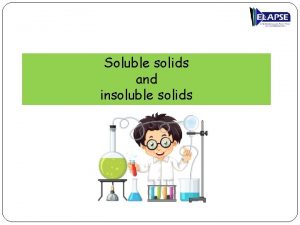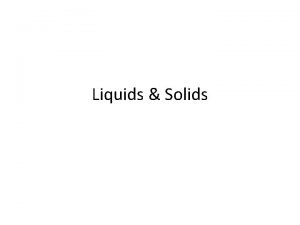Solids liquids and gasses Need to know a




















- Slides: 20

Solids, liquids and gasses

Need to know • (a) define the term density • (b) relate the difference in the structures and densities of solids, liquids and gases to simple ideas of the spacing, ordering and motion of molecules • (c) describe a simple kinetic model for solids, liquids and gases • (e) distinguish between the structure of crystalline and non-crystalline solids with particular reference to metals, polymers and amorphous materials

What is density? • Density is defined as mass per unit volume.

Exercises • Read P 288 • P 295 q 9&10

Models of matter • All matter is made up of particles (atoms or molecules) • The particles are in a constant state of motion (they have kinetic energy)

Gasses • The kinetic theory of gases is the study of the microscopic behavior of molecules and the interactions which lead to macroscopic relationships like the ideal gas law. • Molecules are arranged randomly • The separation of molecules is very large compared to their size. • Molecules move randomly with a distribution of speeds

Liquids • In liquids the separation of molecules is comparable to their size. • Molecules are arranged randomly • Molecules move randomly with a distribution of speeds • Molecules have potential energies due to the intermolecular forces.

Solids • Molecules are in a regular arrangement (crystaline lattice) • Molecules have vibrational kinetic energy but are not free to move

Internal energy

Think • How would you expect the density of a substance to change from solid to liquid to gas? • How can we explain properties of materials using our models – Density – Hardness – Ability to flow

Crystalline • Most solids have periodic arrays of atoms which form what we call a crystal lattice. • Amorphous solids and glasses are exceptions. • One of the implications of the symmetric lattice of atoms is that it can support resonant lattice vibration modes. • These vibrations transport energy and are important in thermal conductivity of nonmetals, and in the heat capacity of all solids.

Metals • A solid is considered to be a metal if it has high electrical and thermal conductivity. • The chemical definition of a metal also includes having a characteristic surface luster or shine. • It is characteristic of metals that they are malleable (can be hammered into sheets) and ductile (can be drawn into wires). • Both the high electrical conductivity and thermal conductivity come from the fact that one or more valence electrons is relatively free to travel throughout the solid material.

Metal properties • Read p 289 • Explain why metals are malleable and ductile. • How would the properties of an alloy of aluminium differ from pure aluminium? • Try to explain why using the molecular model

Structure of polymers • Molecular Weight: – Extremely large molecular weights are to be found in polymers with very long chains. • Molecular Shape: – Polymer chain molecules are strictly straight that the zigzag arrangement of the backbone atoms is disregarded. Single chain bonds are capable of rotation and bending in three dimensions. – Some polymers consists of large number of molecular chains, each of which may bend, coil and kink, leading to extensive intertwining and entanglement of neighboring chain molecules. •

www. themolecularuniverse. com/appl/ appl 1. htm

Polymers • The physical properties of a polymer, such as its strength and flexibility depend on: • Chain length - in general, the longer the chains the stronger the polymer. • Side groups - polar side groups give stronger attraction between polymer chains, making the polymer stronger. • Branching - straight chains can pack together more closely than branched chains, so they are more crystalline and therefore stronger. • Cross-linking - if polymer chains are linked together extensively by covalent bonds, the polymer is harder and more difficult to melt.

What is in a name? – Linear Polymers: Linear polymers are those in which the mer units are joined together end to end in single chain. These long chains are flexible. – Examples of linear polymers are polyethylene, polyvinyl chloride, polystyrene, nylon and the fluorocarbons – Branched Polymers: Polymers in which side-branch chains are connected to the main ones. The packing efficiency is reduced with the formation of side branches, which results in a low density. – Cross linked Polymers: In cross linked polymers, adjacent linear chains are joined one to another at various positions by covalent bonds. Many of the rubber elastic materials are cross linked. In case of rubbers, it is called vulcanization. – Network Polymers: units form three-dimensional networks. These materials have distinctive mechanical and thermal properties. The epoxies and phenol-formaldehyde belong to this group.

Exercises • Read p 291 • Answer the questions on the page. • What is – A thermoset? – A thermoplastic?

Amorphous • An "amorphous solid" is a solid in which there is no long-range order of the positions of the atoms. • Most classes of solid materials can be found or prepared in an amorphous form. • Common window glass is an amorphous solid, • many polymers (such as polystyrene) are amorphous

Research exercise • You will research one of the following topics and report back to the class. – Snowflakes – X-ray crystallography – Crystal lattices – The ideal gas laws – Non newtonian fluids – Nanotubes and buckyballs – Superfluids and superconductors ! – A topic of your choice agreed (quickly) with your teacher.
 Thermal expansion and contraction examples
Thermal expansion and contraction examples Solids liquids and gases section 2 properties of fluids
Solids liquids and gases section 2 properties of fluids Kinetic molecular theory of solids
Kinetic molecular theory of solids Solid liquid gas examples
Solid liquid gas examples Venn diagram of solids liquids and gases
Venn diagram of solids liquids and gases Mass of solid liquid and gas
Mass of solid liquid and gas Process of liquid to gas
Process of liquid to gas Adhesive force
Adhesive force Liquids and solids menu
Liquids and solids menu Lesson 1 thermal energy and the behavior of matter
Lesson 1 thermal energy and the behavior of matter Chapter 14 solids liquids and gases worksheet answers
Chapter 14 solids liquids and gases worksheet answers Liquids and solids
Liquids and solids Particle movement in solids liquids and gases
Particle movement in solids liquids and gases How does sound travel through solids liquids and gases
How does sound travel through solids liquids and gases Properties of solids liquids and gases
Properties of solids liquids and gases Motion of particles in solids, liquids and gases
Motion of particles in solids, liquids and gases Chapter 11 - states of matter: liquids and solids
Chapter 11 - states of matter: liquids and solids Why are gases easy to compress?
Why are gases easy to compress? Constant rate filtration example
Constant rate filtration example Are gasses highly compressible
Are gasses highly compressible How many elements are gasses at room temperature
How many elements are gasses at room temperature











